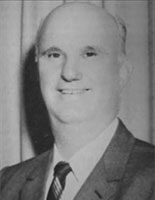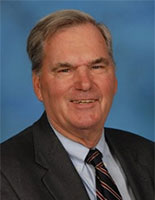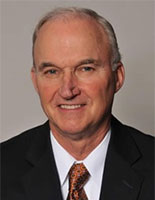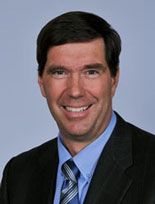“Over a generation, countless studies have been performed at AORI that have led the way internationally to advance the science of total hip and knee arthroplasty and improve patient outcomes. I expect that this collaboration will remain a priority throughout my career.”
Anderson Orthopaedic Research Institute got its name from our founding father, Dr. Otto Anderson Engh. Originally, the name Anderson was Dr. Otto's surname, however, it was changed to Engh when his parents immigrated from Scandinavia. Although Dr. Otto's parents had to change their last name, they kept it in the family by giving it as a middle name to their children and heirs. Thus, it was only fitting when Dr. Otto's son, Charles, wanted to begin a research institute in 1972, that he would name it after his family's original surname. Using his former last name, Anderson, stands in part, as a reminder to persevere through change by embracing and advancing into the future.
 Dr. Otto Anderson Engh was born in 1904. He had his early beginnings in teaching high school science.
He was a performer and musician. But it wasn’t until he finished his medical degree and worked as a
resident at Pennsylvania Crippled Children’s Hospital that he found his calling.
Dr. Otto Anderson Engh was born in 1904. He had his early beginnings in teaching high school science.
He was a performer and musician. But it wasn’t until he finished his medical degree and worked as a
resident at Pennsylvania Crippled Children’s Hospital that he found his calling.
Dr. Otto was a pioneer of orthopaedic services in the Greater Washington DC area. His compassion for children suffering with lower limb disability thrust him forward into opening a hospital and an orthopaedic clinic. His desire to always improve himself as a surgeon and better the lives of his patients, kept him challenging himself towards greater excellence. He believed an excellent surgeon was a curious surgeon.
Dr. Otto believed in research. His sons Charles and Gerard did too. Research teaches a surgeon what works and what does not. Research is the gateway to answer questions about how to improve devices, procedures and patient outcomes. Dr. Otto's son, Dr. Charles Anderson Engh, Sr. stirred by the same desire to develop opened Anderson Orthopaedic Research Clinic in 1972, perhaps with the inspiration of Dr. Otto's drive to excel. Although Dr. Otto passed away in 1988, his lifelong desire to improve the lives of his patients, still remains the focal point and the heartbeat of AORI.
Shortly after Dr. Charles Anderson Engh, Sr. began AORI, he deemed it necessary to collect and build a database of either failed joint arthroplasty implants or to ask for the return of hip or knee implants upon the death of his patients. Since then, AORI's continuous retrieval of implants has given the world of research detailed analysis of collected data. With over 4 decades of collected implant data, AORI’s database is one of the longest outcome databases related to joint replacements in the world, with information from over 35,000 hip and knee joint replacement procedures.
Dr. Otto’s two sons, Dr. Charles and his brother, Dr. Gerard Anderson Engh, best known as Dr. Jerry, became orthopaedic surgeons as well. As time went by, Dr. Charles worked more with hips while Dr. Jerry worked more with knees.
 Dr. Charles saw the cement applied to hip implants as a weak link. He wanted to improve patient
outcomes and lengthen the use of hip replacements. So he worked on developing porous coated hip
implants that did not need cement but instead would give bone a surface to grow into. And it worked!!
Although he was not alone in his pursuit to improve the hip, his porous-coated cementless hip
implant became a national and international game changer thrusting forward the field of total hip
arthroplasty and giving patients longer use of hip implants. In 1992 Dr. Charles won the
John Charnley Award for the study confirming the effectiveness and stability of porous-coated
implants. By 1997, AORI’s research results were showing that 97% of porous-coated stems were
lasting for an average of 12 years.
Dr. Charles saw the cement applied to hip implants as a weak link. He wanted to improve patient
outcomes and lengthen the use of hip replacements. So he worked on developing porous coated hip
implants that did not need cement but instead would give bone a surface to grow into. And it worked!!
Although he was not alone in his pursuit to improve the hip, his porous-coated cementless hip
implant became a national and international game changer thrusting forward the field of total hip
arthroplasty and giving patients longer use of hip implants. In 1992 Dr. Charles won the
John Charnley Award for the study confirming the effectiveness and stability of porous-coated
implants. By 1997, AORI’s research results were showing that 97% of porous-coated stems were
lasting for an average of 12 years.
 As Dr. Charles became more and more devoted to hip replacement surgery, his brother, Dr. Jerry
became more interested in knee replacement surgeries. From early on, both Drs. Charles and Jerry
dove into researching problems, asking questions and searching for solutions through AORI’s
on-going collection of hip and knee devices from patients and the research it inspired.
As Dr. Charles became more and more devoted to hip replacement surgery, his brother, Dr. Jerry
became more interested in knee replacement surgeries. From early on, both Drs. Charles and Jerry
dove into researching problems, asking questions and searching for solutions through AORI’s
on-going collection of hip and knee devices from patients and the research it inspired.
Dr. Jerry saw the need to develop a more compartmental approach to knee replacements. Unlike hip joints, knees may have a healthy aspect and a diseased aspect. Dr. Jerry wanted to save patients from losing all of their bone to a knee replacement if it wasn’t necessary. Dr. Jerry worked to develop and improve upon a compartmental knee implant. He successfully developed a proprietary surgery for the sectional knee implant that would be used to replace only the diseased portion of the knee thus reducing a patient’s bone loss. Dr. Jerry perfected the "minimally invasive uni-compartmental knee arthroplasty for which he became well-known. He also devised special tools and procedures that forever improved the methodologies for this type of surgery that are still in use today.
As well as his work on bone saving techniques for knee arthroplasty, Dr. Jerry also worked on improving bone grafting. In 1997 he won the Ranawat Award for a study showing the efficacy of bone grafts!
Both Drs. Charles and Jerry won several awards for their research work through the end of the 20th century and into the millennium.
There is a saying that when a predecessor passes, they leave the family farm, or in essence, they leave everything productive and of value to their heirs. Nothing could be truer said of the rich heritage that continues to be passed down from grandfather, Dr. Otto Anderson Engh's commitment to excellence to his sons' desires to find answers to improve joint arthroplasty to his grandson, Dr. C. Anderson Engh, otherwise known as Dr. Andy, the President of Anderson Orthopaedic Research Institute, who shares the same passion and commitment to the field of orthopaedic research as his predecessors.
 Dr. Andy together with an outstanding team of research scientists and clinicians continues the
patient work of research. His dedications are to reach beyond AORI’s own walls to collaborate with
the research world around them, to continue to set the standard high for excellence in finding best
practices, longest lasting orthopaedic implant devices, to analyze faster means of patient recovery
and continue to establish and raise the bar for patient success. When Dr. Andy is asked what’s the
best reason for AORI to continue its mission his short answer is: "Happy Patients"!
Dr. Andy together with an outstanding team of research scientists and clinicians continues the
patient work of research. His dedications are to reach beyond AORI’s own walls to collaborate with
the research world around them, to continue to set the standard high for excellence in finding best
practices, longest lasting orthopaedic implant devices, to analyze faster means of patient recovery
and continue to establish and raise the bar for patient success. When Dr. Andy is asked what’s the
best reason for AORI to continue its mission his short answer is: "Happy Patients"!
Anderson Orthopaedic Research institute, otherwise known as AORI, began as one man’s compassionate outreach to disabled children. Although we have grown and changed our scope over the years, our passion for excellence and compassion for humanity continue to compel us forward! Our strongest days are in front of us!